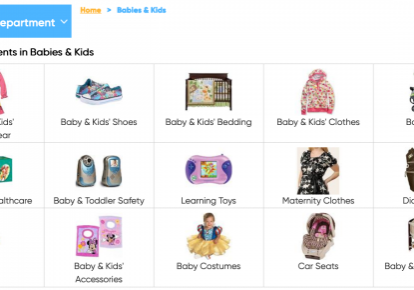
Are you selling children’s products and looking for ways to find and attract new customers?
Many e-tailers selling children’s products use a mix of marketing channels to reach new customers and increase sales. Besides the big online marketplaces like Amazon, eBay and Walmart, there are also retargeting engines, search engine ads, and affiliate marketing channels. These will match you up with content producers and media outlets who review products, such as the famous Good Housekeeping Institute. Here, we will talk about shopping comparison engines, sometimes known as shopbots.
Not all the shopping engines out there are well suited for selling children’s products; some definitely will get you more bang than others. Some of those listed here offer a wider array of marketing services, like search engine marketing and apps for setting up shops either on their site, or on marketplaces like Facebook Shops. We’ve culled through all the shopbots for you to find the best ones for the baby and kids category.
Here’s our list of the best shopping engines for selling children’s products.
Kelkoo
Kelkoo, which originated in the UK but has made huge inroads by now into the U.S. market, is one of the top choices in shopping engines for selling children’s products. It boasts nearly 400,000 products sold by up to 290 different retailers in the baby and kids department. Shoppers can find everything from kids’ Sorel boots to wall art and comic books.
To learn more about the company and how to get started selling on Kelkoo, go here.
Google Shopping
We write a lot about Google Shopping in this space, so this is just a small recap. Basically, Google Shopping leverages the power of Google’s massive search engine in its Shopping site, which works in all web browsers, mobile apps, and voice assistant devices. It’s a kind of hybrid marketplace/shopping comparison engine that draws in product listings from participating merchants and displays them on a custom search page, much like Amazon does.
There are no ad fees or commissions charged to merchants for listing products, and if you sign up with Buy on Google, you can also earn a high enough quality rating from their Retailer Standards to win a coveted Buy box (called “Add to Cart”) right there on the product comparison page. With Buy on Google, a shopper can checkout instantly with their saved Google Pay information, making it that much easier to buy from you.
To learn more about how to sign up with Google Shopping, go here.
Price Grabber
Price Grabber features thousands of baby and kids’ products in twelve different categories, though these tend to be concentrated in the 0-3 age range. Featured categories include furniture, bedding, toys, clothing, accessories and gear. Price Grabber is a subsidiary of Connexity, a database and SEM marketing platform which also owns Shopzilla and Bizrate, two other shopping comparison engines.
To learn how to sign up with Connexity, start here.
Shopmania
Shopmania has fewer categories than the others mentioned above. There is a robust selection of baby and kids’ apparel, games, toys, and health and safety equipment. Major brands selling through the platform include Carter’s, Graco, Maxi Cosi and Safety 1st.
Sellers on Shopmania get access to a free set of tools, such as the app for selling on Facebook. You also get full control over your campaigns, and the ability to set up your own shop on the site. To get started, go here.
Shopzilla
Shopzilla, one of the oldest shopping engines in the U.S., has built a large client base in the baby and kids’ category, with hundreds of thousands of listings across all the major categories, from kids’ shoes to fantasy games, costumes, bedding, furniture. Basically, they have categories for everything you’d need for a kid, except maybe food and your own love.
As mentioned previously, Shopzilla is a wholly owned subsidiary of a larger marketing platform, Connexity. Go there to learn how to get started.
A final word about succeeding with any Shopbot channel
As with any marketing channel, using the highest quality product data with optimized keywords gives you a huge headstart against your competition. You’re not only rewarded with higher search rankings, but including every variant and detail about a product also improves your chances of being seen by shoppers who use highly specific kinds of queries.
The best way to gain this type of edge is with a product feed service that sets you up with high-quality, detailed tagging systems. A feed service will assure your product listings conform to each channel’s unique requirements, and a really good feed service will go beyond the minimum settings to tag all your listings with the kind of rich product data that gives you higher rankings in every kind of search.
Shoppingfeed uses a proprietary product graphing technology with a fluid tagging system that includes 1.2 million product tags for baby and kids products, going way beyond just Size, Color and Age. Ours is the only feed syndication service that offers this unique technology.




